Soccer exercises for u20
- Player 1 passes the ball to player 2.
- Player 1 runs through and player 2 lays the ball wide.
- Player 1 passes the ball to player 3.
- Player 2 meanwhile has run on to the goal.
- Player 3 passes a cross to player 2 and and then player 2 finishes.

- Player 2 dribbles with ball from A to B and passes to C
- Player D passes to A
- Player from B to D
- Player 3 dribbles with ball from C to B and passes to A
- Player D to C
- Player B to D
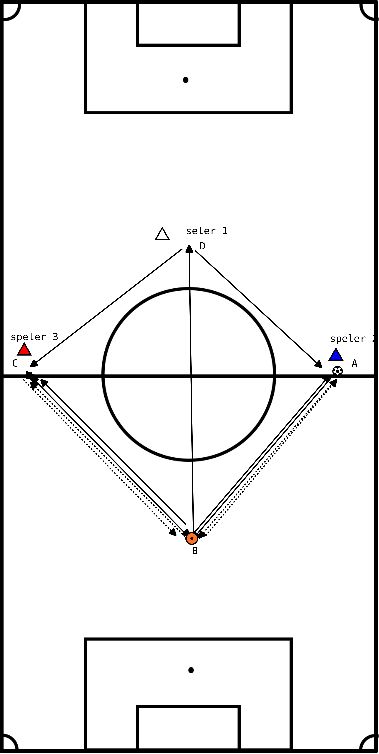
Dribbling exercises:
- Dribbling around the pawns, close together with 1 foot inside-outside foot
- Dribbling around the pawns, close together with 2 feet,
- going left, right foot inside foot, left foot outside side, etc.
- then to the right, left foot inside side, right foot inside side
- 4 pawns in diamond, start and go as in picture tightly past the pawns and same route back.
- Make a quadrant with 4 pawns, dribble tightly around them, left and right turns
- 8 pawns in four squares, two opposite each other.
- Dribble between the pawns from 1 to 2 and back, 1 to 3 and back 1 to 4 and back.
- On reversals cut off or behind stand leg as quickly as possible.

Goal:
Release ball quickly while intensity of run continues
Description:
Release ball quickly while intensity of run continues
Description:
- A plays the ball to asking B
- B rebounds the ball and then runs around the cone and offers to C
- C receives the ball from A
- C does a 1-2 with B
- C joins in behind
The exercise is performed in two groups.

3 variants:
- Pass with handball and then rounding left or right
- Pass with turn through pass to the left or right
- Pass with 2 bounces and then finish left or right

- Pass and dribble
- Player follows the ball
- Pass correctly and pay attention to 1 x hit
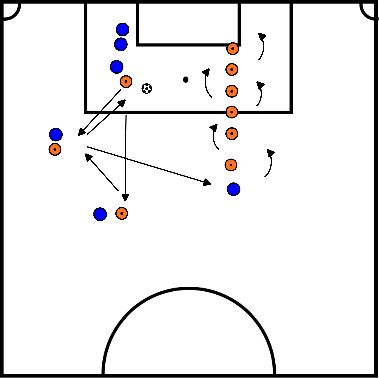
- Distances:
- Rectangle of 15 by 5 meters.
- Pawns B and C 5 meters apart.
- Both 2.5 meters from side and 5 meters from A and D.
- Duration: 10 min.
- After 5 min change direction
Explanation:
- A plays into B
- B drops the ball to C
- C passes to D
- The moment the ball reaches D, A has to be there to make the handball.
- D bounces to A and runs straight through to be played in again.
- A rebounds to D and D rebounds to E.
- E takes ball to starting point.
- Running lines: A becomes B, B becomes C etc.
Points of attention:
- Tight balls by hitting ball in heart, body slightly over ball.
- B must drop the ball on C slightly to outside so that there is a free pass line to D.
- A must time that she/he is present at the right time for the handball with D.
- If she/he is too early and has to wait too long it means in the match that there is opponent in her/his back.
- Is she/he too late D has to wait it means in the match that the opponent can put pressure on D.
- To maintain concentration make sure that at point A the ball is not played until everyone is in place.
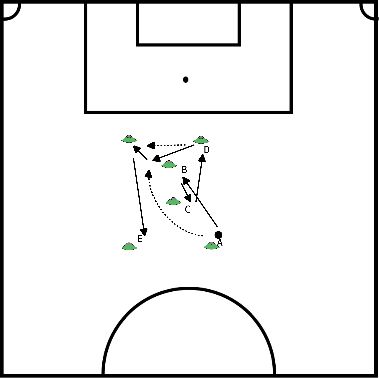
Description:
- Position play, where the overtal must put immediate pressure on ball loss
- Position play, where the overtal must put immediate pressure on ball loss
Game Shape:
- The red team plays the ball around or plays for possession.
- The blue team tries to take the ball away.
- If the blue team has gained possession of the ball, they must try to score as soon as possible in 1 of the 4 goals.
- The red team must prevent this from happening.
- We play 9 x 5.
Dimensions:
- 40x40
- 40x40
Coaching:
- Is it pressured at all when the ball is lost?
- If yes, by whom and by whom not? If no, why not?
- If pressure is applied, how? Aggressively from the idea of capturing the ball immediately or from a shuffling pace?

Description
- Players start at pylons
- Balls are in the middle
- Players kick in place
- When trainer calls, players go toward balls, 2-pairs at 1 ball
- Coach calls left and right, players go to that side
- When trainer calls ball, you have to take the ball with your hands
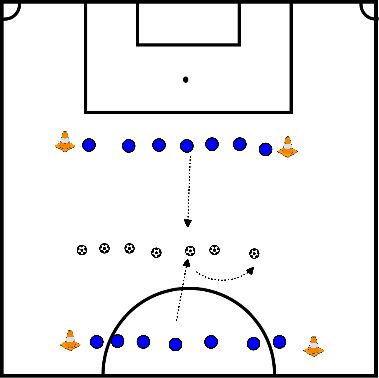
This Exercise can be performed on both sides:
- Good handball
- Tight pass after it
- Lay wide edge 16
- After this round off on goal.
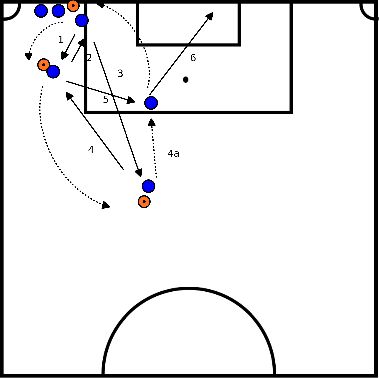
1st exercise:
- Player A plays the ball in to B and runs to B's position.
- Player B stands open turned, takes it and passes it to Player C and so on.
- Point of attention playing in:
- the ball must be hit in the middle so that it stays low.
- The correct technique for this is to lift your shooting leg slightly.
- Passing point:
- The player who accepts the ball should not be facing the ball with his or her body, but turned "open". You create this by positioning your body towards the player you are passing to and with your eyes on the ball.
- Playing around clockwise, the ball is taken on with the left and I play on with the right.
- In the other direction take on with the right and play on with the left.
- If you notice it's too easy, first increase the pace. Then to make it more difficult you can take out the assumption and they have to pass the ball directly.
2nd exercise:
- Player B asks for the ball.
- Player A plays into player B.
- Then B then drops the ball to player A after which he passes it back to player C.
- Player C then drops it to player B and then player B plays it diagonally to player D and so on.
Points of attention:
- The player who plays the ball in must move on after the play-in so that he can ask for the ball, in the middle, between the pawns
- Not further because then the effect is gone with the cross pass.
- The player who rebounds runs around his own pawn to ask for the ball again in the middle.
- This player must make the correct turn when rebounding so that he keeps his eyes on the ball.
- His turn should be short toward the box and not off the play.
In both drills after 8 minutes, change directions of play.
Clockwise passes with right leg, counterclockwise passes with left leg.
Clockwise passes with right leg, counterclockwise passes with left leg.
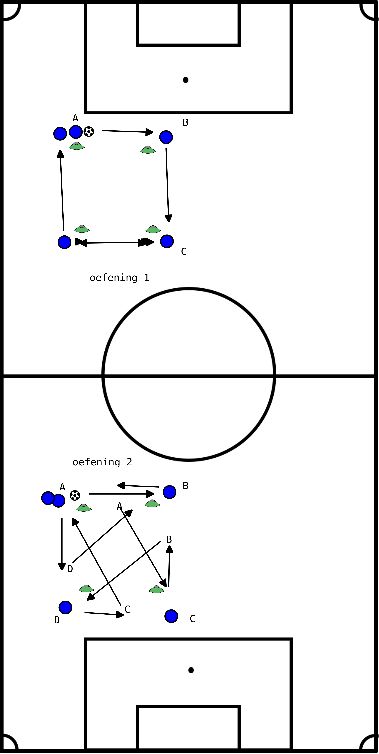
1st exercise:
- Player A plays the ball in to B and runs to B's position.
- Player B is open turned takes it and passes it to Player C and so on.
- Focal point 1 playing in: the ball must be hit in the middle so that it stays low.
- The correct technique for this is to lift your shooting leg slightly.
- Focal point 2 receiving: The player who has to receive the ball should not be facing the ball but rather, as they say, turned open. You create this by positioning your body towards the player you have to pass to and your face is facing the ball. Playing the ball around clockwise, the ball is taken on with the left and I play on with the right. other way round take on with the right and play on with the left.
- If you notice that it is too easy, first increase the tempo. If that also proves too easy then you take out the takeover and they have to pass the ball directly.
2nd exercise:
- Player B asks for the ball, player A plays into player B. Then B drops the ball to player A who then passes it on to player C.
- Player C then drops it to player B and then player B plays it diagonally to player D and so on.
Points of attention:
- The player who plays the ball in must move on after playing in so that he asks for the ball in the middle between the pawns
- Not further because then the cross pass effect is gone.
- The player who bounces the ball back runs around his own pawn to ask for the ball again in the middle.
- It is imperative that this player makes the correct turn when rebounding so that he keeps his eyes on the ball.
- His turn should be short toward the box and not off the play.









